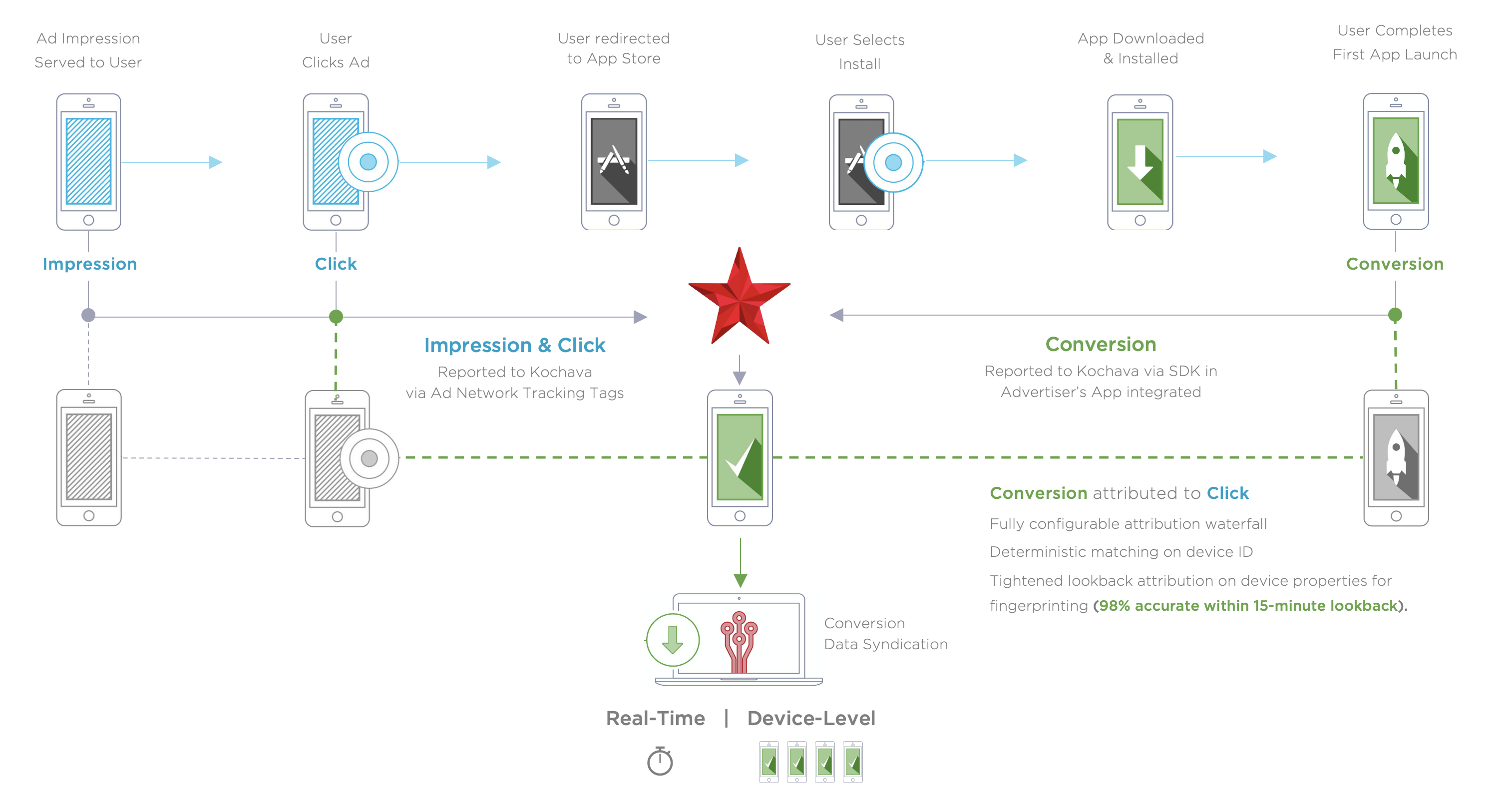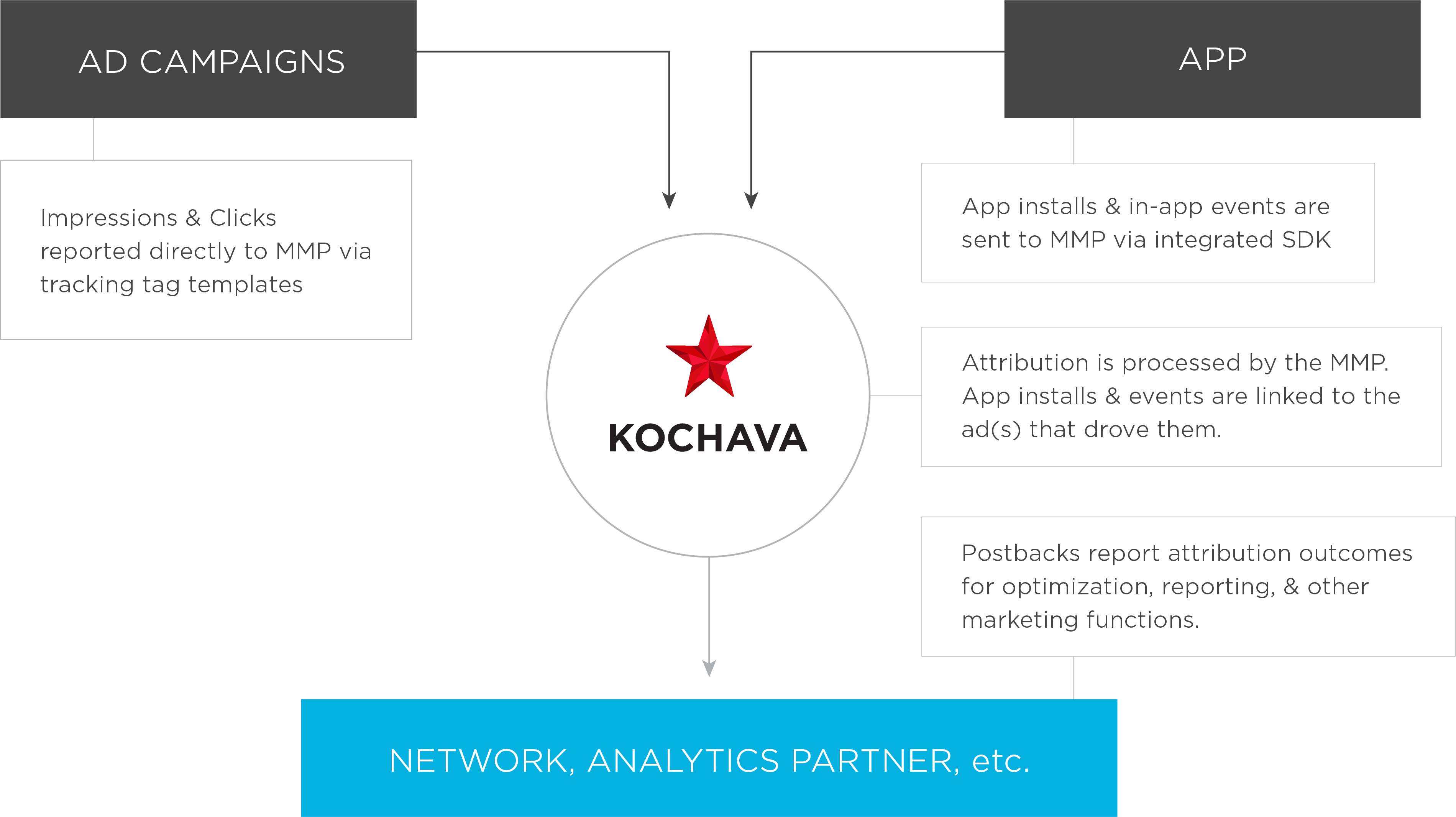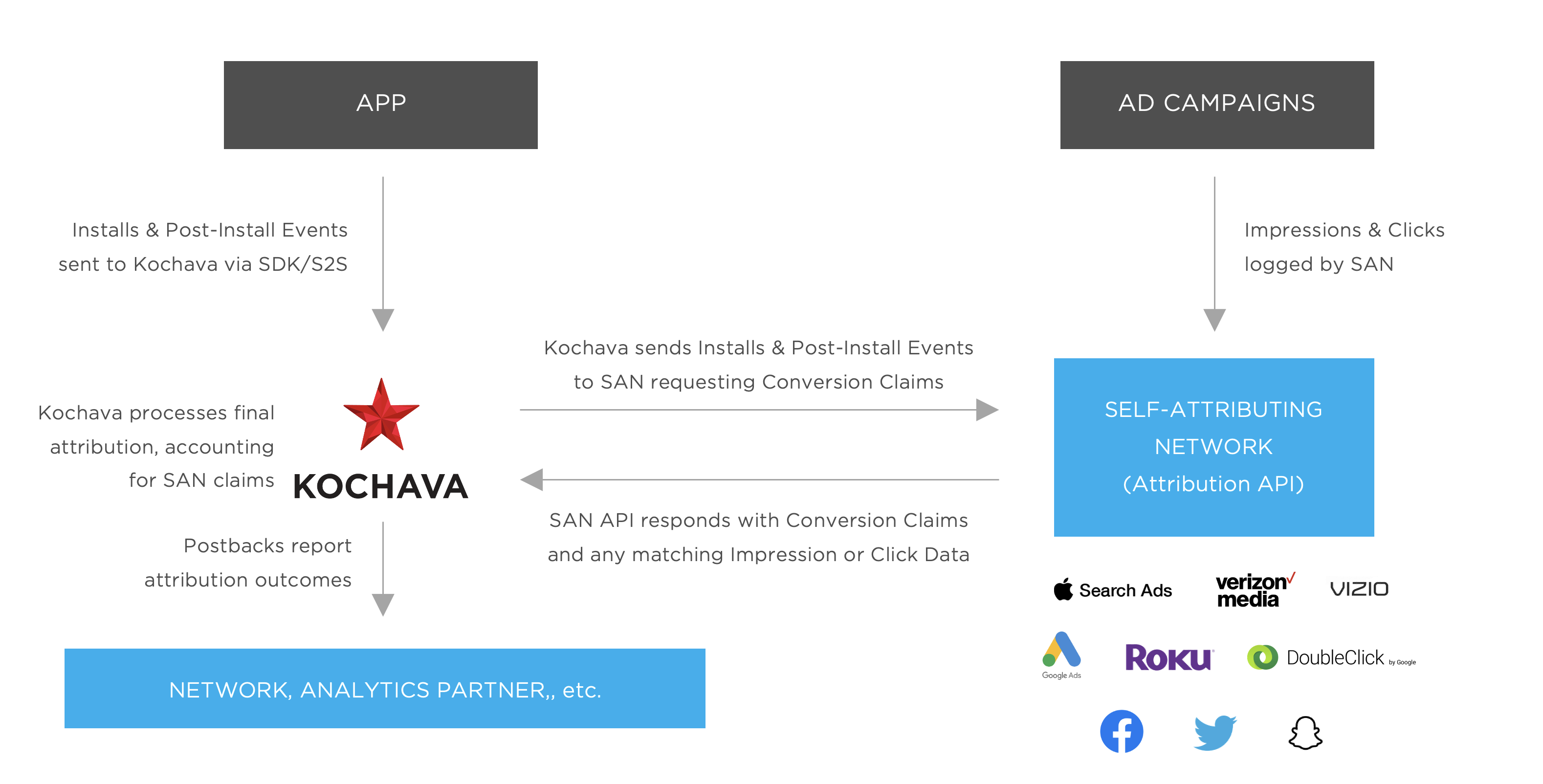Drive sustainable growth for your mobile campaign
What is mobile attribution?
Is attribution lingo giving you a headache? Maybe you’re a newly minted marketer looking to learn or a seasoned veteran just needing a refresher. Whatever the case may be, you’ve come to the right place!
Attribution identifies user actions that contribute to the desired outcome then assigns a value to each event. Mobile app attribution is the same concept but applied exclusively to mobile apps. For a marketer to determine the success of their campaign(s), they need to understand users’ actions within an app. What content users did or didn’t click on, where those users came from, and what actions they took once they got there. A marketer’s job relies on results, which is what attribution guarantees. Trying to modify campaigns and optimize return on ad spend (ROAS) becomes much more difficult without it.
This is where mobile measurement partners (MMP), like Kochava, come into play—trying to process the volume of data that accurate attribution requires would be nothing short of a headache without the help of an MMP. For example, integrating Kochava’s software development kit (SDK) on your mobile app allows marketers to make decisions about their campaigns based on data in real-time. With an MMP, marketers can access a broader data pool without the hassle of collecting it themselves.
If that still doesn’t clarify things for you, don’t worry – you’re not alone. Let’s break this concept down into manageable steps.
How does it work?

At first glance, mobile app attribution can be confusing and intimidating, but it doesn’t have to be that way! Let’s walk through the attribution process together.
The mobile adtech ecosystem
There are two sides to the mobile adtech ecosystem: the demand and the supply. These sides work in tandem to serve digital ads. This method is also known as programmatic real-time bidding (RTB), the buying and selling of ad impressions on an ad exchange in real-time. In this context, demand is a broad industry term used to describe advertisers, ads, and more within the ecosystem. Supply is another general industry term for traffic sources and their owners.
The ad exchange connects the demand-side platform (DSP) and supply-side platform (SSP) to facilitate RTB. The ad exchange acts as a centralized system and awards the highest bidder for each ad space sold.
Where MMPs fit in
Measurement and attribution providers like Kochava come into play after an ad has been served to a user. In this context, there are two types of data that MMPs collect and share with their clients: ad signal and app signal. Ad signal is impression and click data, while app signal is installs and post-install activity. Once a user interacts with an ad, MMPs will collect both streams of data then determine who deserves credit for driving that user conversion. For Kochava, the intake of app and ad signal allows our system to determine which click or impression drove which install/post-install event and perform attribution. After this process, a postback is sent to an integrated ad network partner to inform them that they’ve been awarded attribution credit. That sums up the basic operation of mobile app attribution.
Self-attributing networks and attribution
Two kinds of networks look to MMPs for mobile app attribution: traditional networks and self-attributing networks (SANs). Traditional networks rely on MMPs because they lack the necessary capabilities to determine users’ paths from ad interaction within their network to install/post-install activities on their client’s apps. The postbacks they receive from MMPs are used for anything from billing for client campaigns, audience suppression, targeting, or campaign optimization.
Unlike traditional networks, SANs do not share a holistic view of their data. Instead, these super publishers, like Facebook and Google, only share the bare minimum of the necessary information. They offer advertisers access to their user base to market their brands while limiting the detail they share externally on campaign performance and individual users. The term for this is “walled garden,” where advertisers can peer over the “wall” but cannot enter the “garden.”

The data flow of SANs is typically inverse of traditional networks. Measurement and attribution partners will receive notification of install/post-install events from the client’s apps, then send in a claim request to any SANs integrated into their system. A claim request is sent to the SAN asking if they have ad data (clicks or impressions) from the same user or device that has triggered an install and/or post-install event. After receiving the claim request, the SAN will send a claim response either confirming or denying an ad interaction through their network by that specific device. That sums up the basic attribution process with a SAN.

In the section below, you’ll find many of the terms we’ve discussed and some new ones that you’ll be sure to come across.
Must-know terms for mobile app attribution
Ad Exchange – A technology platform in the ad space based on real-time ad auctions for buying and selling ad impressions.
Ad Network – A platform that connects advertisers with publishers and acts as a middle point between the two.
Advertiser – Any person or company looking to promote a brand, service, or product via banners and text links on publisher sites and apps.
Attribution – The identification of a set of user actions that contribute to the desired outcome and then the assignment of a value to each of these events
Claim Request – A claim request is sent to a SAN asking if they have ad data (clicks or impressions) from the same device that has triggered an install and/or post-install event to be tracked in the MMPs system.
Claim Response – This is sent by a SAN either confirming or denying an ad interaction by a specific device within their network as requested by an MMP.
Deterministic Attribution – This uses device IDs to identify the same user across different devices. Because the device ID is used, the match is 100% accurate for attribution.
Fractional Attribution – The practice of attributing an install or event across more than one source based on the recency of a click or impression.
Lookback Window – This defines how far back, from the time of install or in-app conversion, to consider clicks and impressions for attribution.
Postback
- Postback Event: A string of information sent to a network’s specific URL containing information about the post-install event pertinent to the network.
- Postback Conversion: A string of information sent to a network’s specific URL containing information about the conversion pertinent to the network.
Probabilistic Attribution – A method of performing attribution when no device identifiers are present. Probabilistic can be up to 85 – 90% accurate and typically relies on IP addresses and device user agents, which are non-deterministic.
Publisher – Any person or company that publishes content via a site, app, or blog. Publishers sell space on these platforms to app developers (buyers) and agencies, and advertisers use this space to run their ads.
Self-Attributing Network (SAN) – A SAN is a super publisher, such as Facebook or Google, that performs attribution on their traffic independently and notifies Kochava of the installs they have claimed.
Real-Time Bidding (RTB) – RTB is the buying and selling of ad impressions on an online auction marketplace (or ad exchange) in real-time.
Demand-Side Platform (DSP) – A DSP is an advertising platform that makes it easier for an advertiser to buy and sell advertising on multiple ad exchanges.
Supply-Side Platform (SSP) – An SSP software system allows publishers to offer their available inventory to ad exchanges.
Ad Signal
- Impression: This is when an advertisement of other digital media is seen by a user.
- Click: The act of clicking on an ad (banner or text link) that has been served to a mobile screen.
App Signal
- Install: This happens when a user downloads an app and opens it for the first time.
- Post-Install Activity: This is an in-app activity of various forms that takes place any time after the install has occurred. This can include registration, in-app purchase, free trial, or subscription.
Walled Garden – This term is often used to describe certain super publisher platforms that operate as private ecosystems. These publishers offer advertisers access to their user base to market their brands while limiting the detail they share externally on campaign performance and individual users.
Attribution empowers marketers
By utilizing attribution, marketers can:
- Stretch their dollar Discover which campaigns are underperforming and reduce ad spend waste while maximizing results.
- Compare and contrast campaigns Gain faster insights into your campaigns’ true, unbiased results while minimizing time lost on stale content.
- Better understand their users Uncover your users’ journey from the first ad interaction to install and post-install activities.
Stay up-to-date
The digital space is always changing. Keep your marketing edge sharp by subscribing to our newsletter.
For more information, visit our website or reach us at support@kochava.com.




